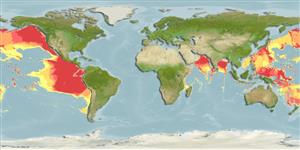Teleostei (teleosts) >
Ophidiiformes (Cusk eels) >
Ophidiidae (Cusk-eels) > Brotulotaeniinae
Etymology: Brotulotaenia: Latin, brotula, -ae = little, bud, shoot + Latin, taenia = stripe (Ref. 45335).
Eponymy: Jørgen G Nielsen (d: 1932) is a Danish zoologist. [...] (Ref. 128868), visit book page.
More on author: Cohen.
Environment: milieu / climate zone / depth range / distribution range
Ecology
Marine; bathypelagic; depth range 800 - 900 m (Ref. 44037). Deep-water; 39°N - 15°S, 141°E - 117°W
Indo-Pacific: from Japan, east to Mexico and to southeast Pacific.
Size / Weight / Age
Maturity: Lm ? range ? - ? cm
Max length : 8.2 cm SL male/unsexed; (Ref. 42080)
Dorsal spines (total): 0; Dorsal soft rays (total): 85 - 91; Anal spines: 0; Anal soft rays: 62 - 72; Vertebrae: 68 - 72. Scales small, non-imbricate prickles; opercle with no spine; median basibranchial tooth patch absent; gill rakers are tooth-bearing tubercles; otolith very small and rounded; precaudal vertebrae 12-15 (Ref. 34024).
Uncommon species (Ref. 34024). Reproductive strategy possibly similar to other members of this family featuring oviparity, with oval pelagic eggs floating in a gelatinous mass (Ref. 205).
Life cycle and mating behavior
Maturity | Reproduction | Spawning | Eggs | Fecundity | Larvae
Nielsen, J.G., D.M. Cohen, D.F. Markle and C.R. Robins, 1999. Ophidiiform fishes of the world (Order Ophidiiformes). An annotated and illustrated catalogue of pearlfishes, cusk-eels, brotulas and other ophidiiform fishes known to date. FAO Fish. Synop. 125(18):178p. Rome: FAO. (Ref. 34024)
IUCN Red List Status (Ref. 130435: Version 2024-1)
Threat to humans
Harmless
Human uses
Fisheries: of no interest
Tools
Special reports
Download XML
Internet sources
Estimates based on models
Preferred temperature (Ref.
123201): 1.9 - 2.6, mean 2.2 °C (based on 6 cells).
Phylogenetic diversity index (Ref.
82804): PD
50 = 0.5625 [Uniqueness, from 0.5 = low to 2.0 = high].
Bayesian length-weight: a=0.01000 (0.00244 - 0.04107), b=3.04 (2.81 - 3.27), in cm total length, based on all LWR estimates for this body shape (Ref.
93245).
Trophic level (Ref.
69278): 3.3 ±0.6 se; based on size and trophs of closest relatives
Resilience (Ref.
120179): High, minimum population doubling time less than 15 months (Preliminary K or Fecundity.).
Fishing Vulnerability (Ref.
59153): Low vulnerability (10 of 100).
